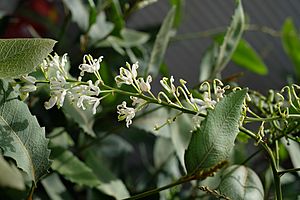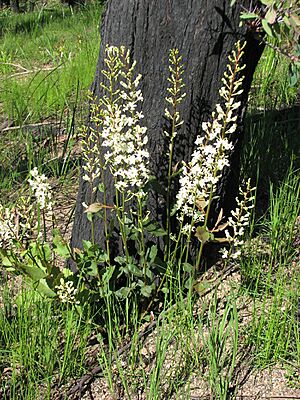Holly lomatia facts for kids
Quick facts for kids Holly lomatia |
|
|---|---|
 |
|
| Lomatia ilicifolia (cultivated) in Ku-Ring-Gai Wildflower Garden (N.S.W.) | |
| Scientific classification | |
| Genus: |
Lomatia
|
| Species: |
ilicifolia
|
| Synonyms | |
|
Embothrium ilicifolium (R.Br.) Poir. Tricondylus ilicifolius (R.Br.) Kuntze nom. rej. |
|
Lomatia ilicifolia, often called holly lomatia or native holly, is a unique plant that belongs to the family Proteaceae. It grows naturally only in south-eastern Australia. This plant is a strong, upright shrub. Its new growth has rusty-coloured hairs. It can even grow back after a bushfire from a special woody base called a lignotuber. It has dull green, tough, prickly leaves that look a bit like holly. It also produces long sprays of cream-coloured flowers, usually after a fire.
Contents
What Does Holly Lomatia Look Like?
Lomatia ilicifolia is a sturdy, upright shrub that can grow between 0.5 to 3 metres (about 1.5 to 10 feet) tall. Its young leaves and flower buds are covered in soft, rust-coloured hairs.
Leaves and Stems
The leaves are a dull green colour and feel leathery. They look like holly leaves and are mostly smooth, meaning they don't have many hairs. They can be egg-shaped, lance-shaped, or oval. Each leaf is usually 6 to 20 centimetres (about 2.5 to 8 inches) long and 2.5 to 3.5 centimetres (about 1 to 1.5 inches) wide. They have sharp, spiky teeth along their edges. You can also see a clear network of veins on the leaves.
Flowers and Fruit
The flowers grow in long, spike-like clusters at the ends of the stems. These clusters can be 15 to 30 centimetres (about 6 to 12 inches) long. Each flower sits on a small stalk that is about 8 to 12 millimetres (about 0.3 to 0.5 inches) long. The flowers are white or cream-coloured and are about 10 to 12 millimetres (about 0.4 to 0.5 inches) long. They are mostly smooth.
Holly lomatia usually flowers from November to February. This often happens after a bushfire from the previous summer. After the flowers, the plant produces fruit about three months later. The fruit is a dark brown, leathery pod called a follicle. It is 15 to 30 millimetres (about 0.6 to 1.2 inches) long and holds about ten winged seeds inside.
Sometimes, Lomatia ilicifolia can mix with other Lomatia species like L. myricoides, L. silaifolia, and L. fraseri. This happens when these different types of plants grow close together.
How Holly Lomatia Got Its Name
Lomatia ilicifolia was first officially described in 1810 by a botanist named Robert Brown. He wrote about it after finding a sample near Port Phillip in Australia. His description was published in a scientific journal called Transactions of the Linnean Society of London.
The second part of the plant's name, ilicifolia, comes from two Latin words. Ilex, ilicis means "holm-oak," which is a type of tree in the holly family. Folium means "leaf." So, ilicifolia basically means "holly-leaved," which makes sense because its leaves look like holly!
Where Holly Lomatia Grows
Native holly is common in south-eastern Victoria. You can find it growing in open areas like heathlands or woodlands. Sometimes it also grows in mountain forests. It spreads from the Otway Ranges all the way to Gippsland. In New South Wales, it grows in dry sclerophyll forests along the coast and nearby mountain ranges, south of Moss Vale.
Holly Lomatia and Nature
Native holly is important for nature because it attracts butterflies that feed on nectar. These butterflies help to pollinate the plant.
Growing Holly Lomatia in Gardens
This lomatia is a tough plant that grows slowly. It has interesting leaves, pretty flowers, and attractive fruit, which makes it a good choice for gardens. It can handle frost and grows well in sunny spots or areas with some shade.


